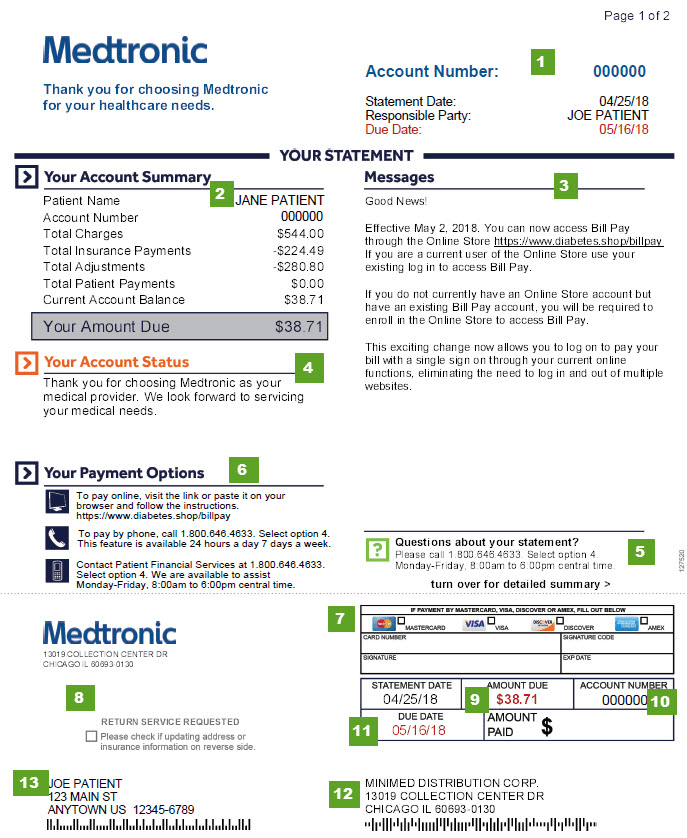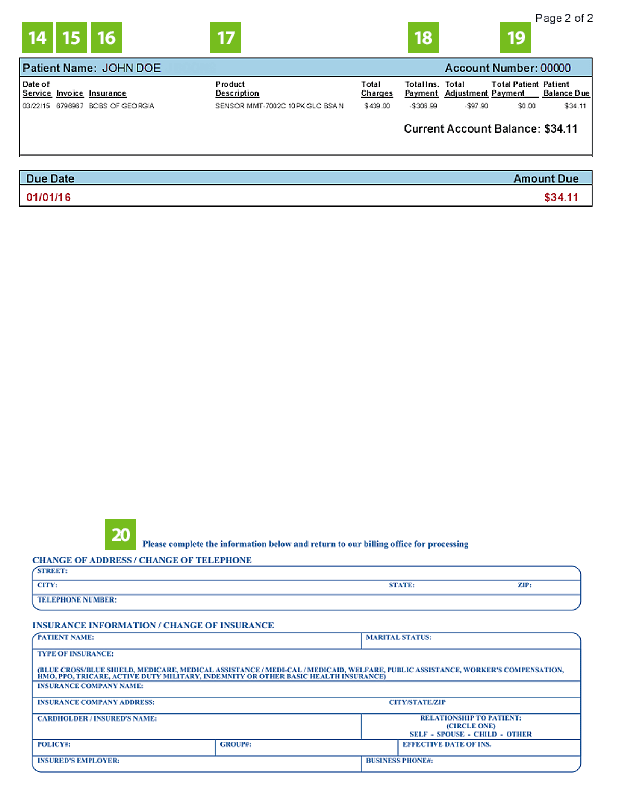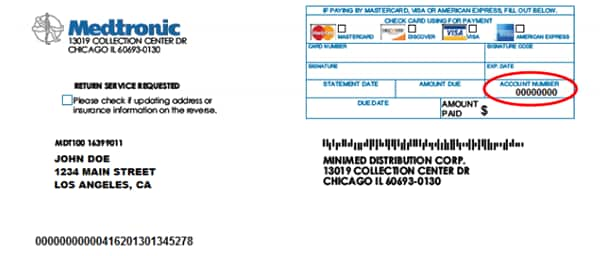Billing
We work closely with your insurance company to make sure you are taken care of. Since every insurance company is different, expect it to take 75-90 days after you receive a new device and supplies to receive your first bill. If you purchased any accessories, and have asked to be billed directly, there will be a separate statement for these items.
If your insurance company needs more information, this may take longer. Your final out-of-pocket cost will depend on the balance from your insurance company after we have worked with them on your behalf.
- Date the statement was printed
- Summary of your account balance
- Important messages and reminders
- The status of your account
- Contact the Patient Financial Services Team at 1-800-646-4633, select option 4
- Your payment options
- Area to complete if paying by debit or credit card
- Check this box if providing updated address or insurance information on the back
- Total amount due including any previously unpaid balances
- Your unique Medtronic identification number
- Date payment is due
- Make checks payable to "MiniMed Distribution Corp." and mail to this address
- Name of person financially responsible
- The date for services provided
- The invoice number for a specific date of service
- The payer who was billed
- Items provided to you on a specific date of service
- Amount paid by your insurance for a particular claim or date of service
- Amount you have paid Medtronic for each individual claim or date of service
- Complete this section if you need to update any personal or insurance information.
Important: If updating information, check the box on the first page (Item 7)


Our new website for Online Bill Pay is simple, secure, and available to you anytime you need it. There, you can:
- Access your Medtronic Diabetes statement information 24 hours a day, seven days a week
- Use your Visa, MasterCard, Discover, or American Express checking/savings account to pay your balance online
New to Online Bill Pay? You can access the portal through Diabetes.shop. Simply log into your account and select Bill pay from the menu. Need to create an account? Visit Diabetes.shop and click Create an account to register.
Once you have set up your Diabetes.shop account, you will have access to a secure and easy way to manage your Medtronic Diabetes billing online.
Go to Diabetes.shop to set up your account today.
Debit or credit card
Pay with a debit or credit card by following these steps:
- Fill in the required information in the Account Status section on your bill
- The type of card: Visa, MasterCard, Discover, or American Express
- Card number
- Signature code (the 3-digit security code listed on the back of your card)
- Signature
- Expiration date
- Tear off the bottom piece of the bill
- Put it in the envelope that came with your bill, making sure the address is visible in the clear window
Check or money order
- Make your check out to: MiniMed Distribution Corp. and send to the following address. Note that any correspondence related to your billing statement may also be received at this address.
- The mailing address is:
MiniMed Distribution Corp.
13019 Collection Center Drive
Chicago, IL 60693-0130
- The mailing address is:
- Also make sure to include your account number on the memo line of the check. Can't find your account number?

- If you don't have a copy of your billing statement, a Patient Financial Team Member can look it up for you Monday–Friday, 8 a.m.–6 p.m. CT at 1-800-646-4633 and select option 4.
Call us
Call a Patient Financial Team Member Monday–Friday, 8:00 a.m.–6:00 p.m. CT at 1-800-646-4633 and select option 4 to use a debit or credit card.
When you call, be prepared to provide:
- The type of card: Visa, MasterCard, Discover, or American Express
- Name on the card
- Expiration date
- Debit or credit card number
- Security code listed on the back of your card
You can now pay by phone Monday–Friday, 8:00 a.m.–6:00 p.m. CT by calling 1-800-646-4633 and select option 4. You will need the customer’s Medtronic Diabetes account number and date of birth to access this option.
When you call, be prepared to provide:
- The type of card: Visa, MasterCard, Discover, or American Express
- Name on the card
- Expiration date
- Debit or credit card number
- Security code listed on the back of your card
With the many tasks diabetes involves, one thing we don't want you to worry about is finances. We have innovative Financial Assistance Programs to help ensure that you stay on our therapy so you can continue to live your life, your way.
Visit our financial support page to learn more.
To check and see if you are eligible for financial assistance, call us Monday–Friday, 8:00 a.m.–6:00 p.m. CT at 1-800-646-4633 and select option 4.
This is a health insurance company's system of approving the performance of medical services and/or the fulfillment of medical orders. An authorization is not a guarantee of payment.
An itemized bill submitted by a medical or durable medical equipment provider to the insurance company on behalf of the patient, customer, and/or insured to pay for items or services that were administered by the healthcare provider.
If your insurance requires this, it is a percentage that you (the insured) pay after meeting your health insurance plan deductible. It is usually written as a pair of percentages with the health insurance's portion stated first (for example 80/20 or 70/30).
Generally, coinsurance applies to PPO (Preferred Provider Organization), POS (Point of Service), and EPO (Exclusive Provider Organization) plans.
A copayment is a flat fee required by some insurance companies to pay for services like office visits and pharmacy prescriptions. Copayment amount may change based on the service being provided and are usually are seen with Health Maintenance Organization plan types.
If you have more than one health plan, a coordination of benefits will determine the order each company will pay. If you receive insurance coverage through your employer, this plan functions as the primary while any other plan would be secondary (for example insurance obtained through the employment of a spouse). The primary insurance plan will pay their percentage for the claim, and the remainder will be billed to the secondary insurance. Having a secondary insurance plan does not guarantee that it will pay what the primary does not.
A medical provider that has an agreement with an insurance plan to accept their patients at a previously agreed upon rate of payment. The plan will pay a higher percentage of the claim when using a contracted provider compared to a provider that is not contracted.
These are services and/or items for which an insurance plan will pay. With regards to diabetes supplies, examples of items covered by health insurance include insulin pump, supplies needed to use the insulin pump, as well as other diabetes management supplies.
This is the date medical services were provided to you. For medical items received from Medtronic, it is the date the product is shipped.
The dollar amount your health insurance plan may require you to pay out-of-pocket each year before your insurance plan begins to make payments. Not all health insurance plans require a deductible. Generally, deductible applies to Preferred Provider Organization plans.
This is a situation when an insurance plan will not pay a claim/service, procedure or prescription. This may be because you do not meet certain criteria, or the item is not covered by specific insurance policies.
This benefit provides coverage for medical equipment used for home healthcare. A prescription from a healthcare provider is required. The items covered under this benefit can vary by insurance plan but typical diabetes items include insulin pumps, and some diabetes management supplies.
This is a statement from your health insurance company that provides details on recent medical care charges and benefits plan payments. It includes a summary of services provided, the amount paid by your plan to the provider, and your financial responsibility. It is important to note that Health Maintenance Organization plans do not always provide an Explanation of Benefits.
An EPO insurance plan is a network of individual medical care providers, who have entered into written agreement with an insurer to provide health insurance to subscribers. EPOs are similar to HMOs as they require the subscriber to select a primary care physician or medical group who will be responsible for issuing referrals to specialists. You must stay within the network and use preferred providers to receive any reimbursement or benefit for medical care provided, with some exceptions in cases of emergency. EPOs are also similar to PPOs as their benefits are similar but the provider panel from which an EPO member may obtain care is smaller than with a PPO.
Programs offered by some employers allow for employees to set aside pretax money from their paycheck, to pay for the employee’s share of insurance premiums or medical expenses that their insurance plan does not cover. Usually, this money must be used within the benefit year.
The maximum amount of money that the health insurance plan will pay for a specific medical service or procedure.
An HMO is a type of group health insurance plan where the medical needs are provided by a managed system of medical care. The system provides medical care through a group of doctors, medical personnel, and facilities that work directly for the HMO. The care is done at their clinics by their doctors. You are required to choose a primary care provider who will direct your medical needs through one of the system's clinics and obtain any authorizations necessary for the patient to receive specialty services. You must stay within the system in order to receive any reimbursement or benefit for medical care provided.
This is a type of health insurance that covers most serious medical expenses, such as hospitalization, up to a maximum limit, usually after a deductible and coinsurance has been met by the policyholder.
A network is a group of healthcare providers and hospitals that provide services to members of a particular health insurance company's plan. The network provides services at lower rates than usual.
These are services and/or items for which an insurance plan will not cover. Depending on your insurance company's response, as identified on your Explanation of Benefits, the member can be held financially responsible for items not covered. With regards to diabetes supplies, typical examples of items not covered by health insurance may include the Serter® auto-insertion devices or any accessories for your insulin pump (for example a pouch or case).
Some benefits packages identify a maximum on the yearly out of pocket expense paid for health related services. Depending on your health plan, these expenses may include an annual deductible, coinsurance, and copayments. Once your yearly maximum out of pocket expense has been reached, your health plan benefits can increase up to 100%. For more information please review your benefit package with your insurance carrier.
A payer or payor is a company that provides health insurance plans. Some examples of these are Blue Cross/Blue Shield and Medicare.
A PBM is a third-party administrator of prescription drug programs. They are responsible for processing and paying prescription claims. Some insurance companies will classify your diabetes management supplies (reservoirs, infusion sets, sensors) as a pharmacy benefit rather than durable medical equipment.
A POS allows you to choose providers or specialists within the POS network referred by your primary care provider, or to self-refer to a provider outside the network. You will receive the highest level of benefits if you use providers inside the network. When you enroll in a POS insurance plan, you are required to choose a primary care provider who must be chosen from within the healthcare network and becomes your "point of service." If you choose to go outside the network, it becomes your responsibility to fill out forms, send bills in for payment, and keep an accurate account of healthcare receipts. With POS health insurance you have greater freedom, but at a higher cost.
A policyholder is the owner of an insurance policy; usually, but not always, the person who is insured.
A PPO is a organization of hospitals and healthcare providers who have contracted with an insurer or a third-party administrator to provide healthcare. People who have PPOs have more flexibility to choose a primary care provider and to go to a specialist without first obtaining a referral. PPO members can also be reimbursed (either partially or fully) if they use a doctor that is not listed in the network, unlike EPO members. If you choose to see someone out of network the deductible may be higher and the percentage that insurance pays may be lower.
Generally, you will have a yearly deductible to pay out of pocket, before the insurance company will start paying for medical services. You may also pay a copayment at the time of each medical service/office visit. The insurance company usually pays a percentage of the medical fees for the in-network doctor, with the insured being responsible for the remainder of the bill.
A referral is the recommendation of a healthcare provider. In HMO plans, a referral is usually necessary to see any specialist other than your primary care physician (PCP), if you want the service to be covered. The referral is obtained from your PCP, who may require an in office consult.
This is the total amount your health insurance plan requires you to pay towards the cost of your healthcare. Once you reach your maximum amount, your insurance plan will cover your expenses at 100%. For example: If your plan has an out-of-pocket of $2,500, once your payments have totaled $2,500 in a plan year, all other claims are paid at a 100%.